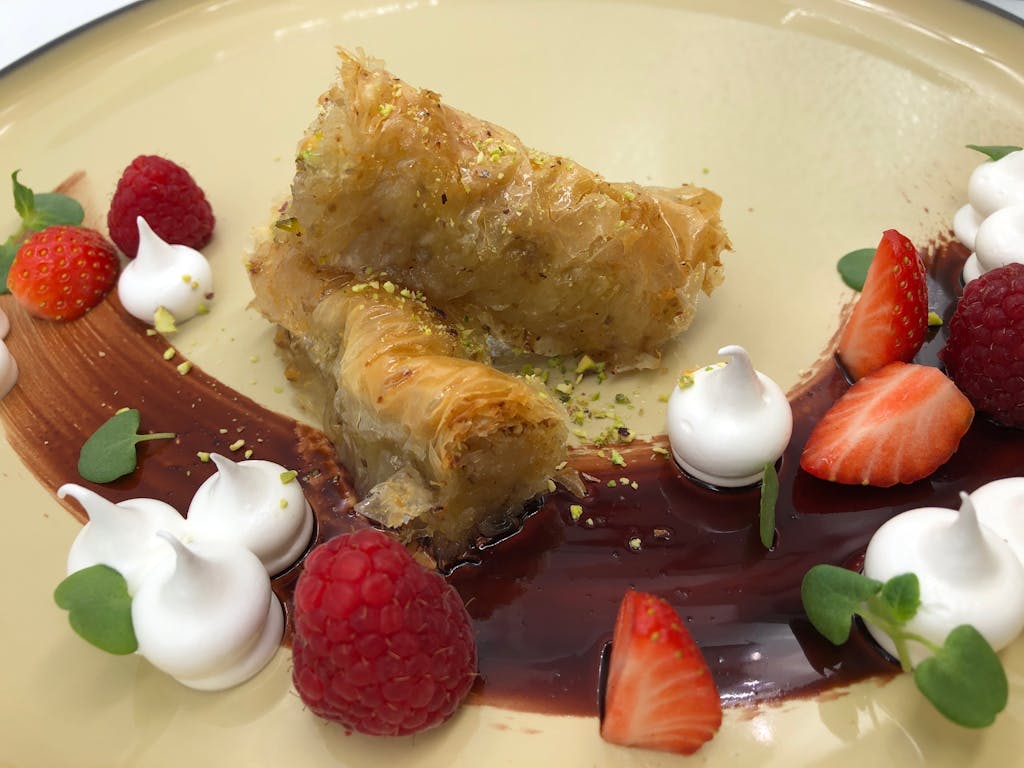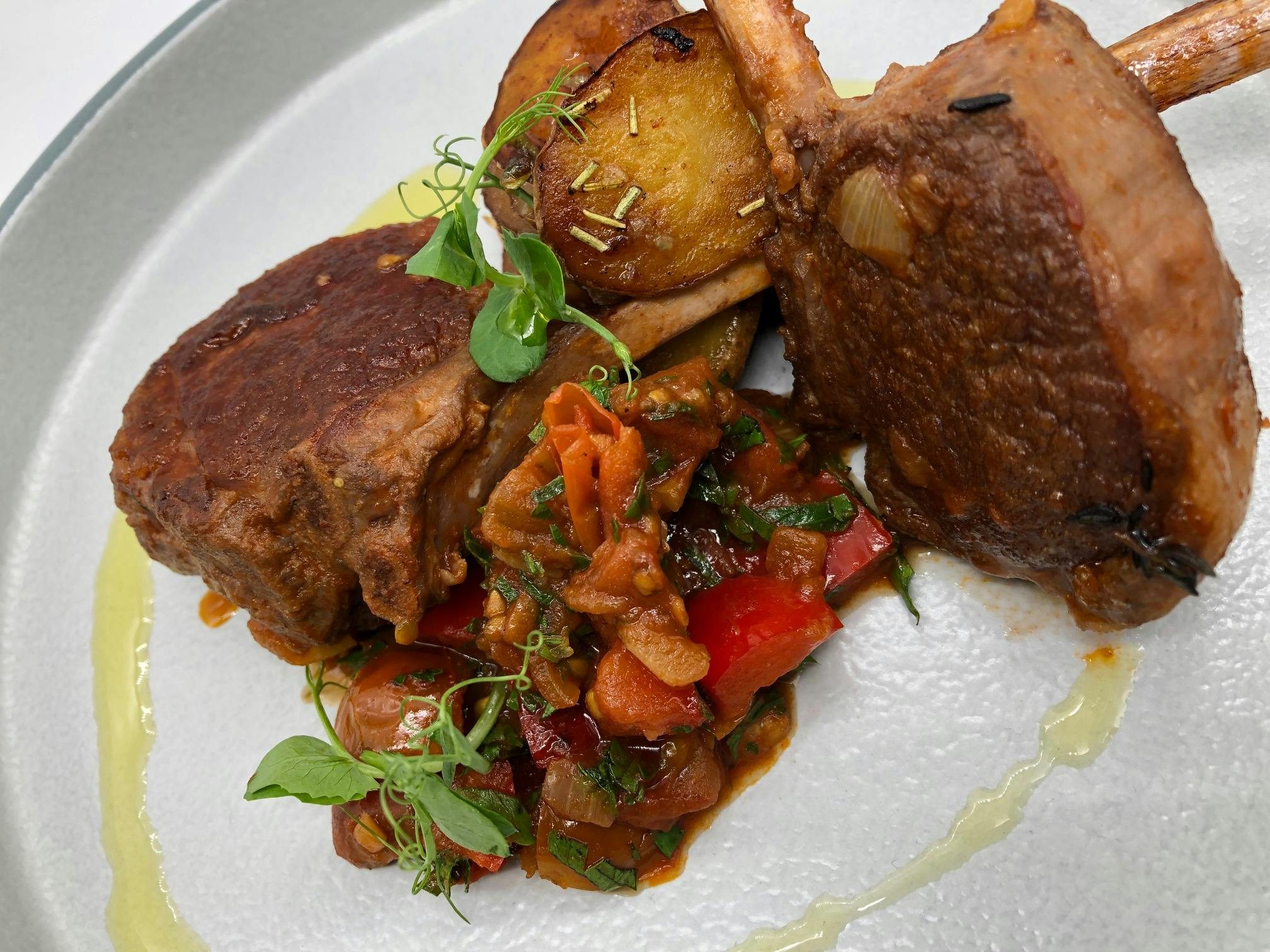A Taste of Greece With S.A.L.T.
For millennia, Greek cuisine has been admired for a balance of three elements: olive oil, grain and wine. And while the pillars remain standing, constant trade and looming empires have left a mark on the regional gastronomy, even the more rustic cuisine of the islands. A taste of Greece reflects the traces of past conquerors, migrations, domination and resilience, which still linger in many popular dishes, but those stories are best told through ingredients and a bottle of Greek wine.
The pleasure of eating across the Eastern Mediterranean and exploring the delights of the Aegean Sea will take off in the S.A.L.T. kitchen, when chefs guide us through the recipes of the Greek Isles.
We asked our award-winning chef, Eva Mulligan, a S.A.L.T. host on the Silver Moon and David Bilsland, a culinary trainer and chef instructor, for a favorite recipe from their travels. They chose a tender roasted lamb from the island of Cyprus, where the Goddess of Love Aphrodite is said to have lived, and a golden phyllo dessert drenched in a lemony syrup from the port city of Alexandroupoli in Eastern Greece.
Lamb Kleftiko
Recipe courtesy S.A.L.T Kitchen restaurant. Featured on the Terrain menu for the port of Limassol, Cyprus, where the dish is quite popular.
The history of this aromatic and delicious slow-cooked roast with herbs, vegetables and lemon begins with an intriguing name: “stolen” lamb.
Passed down for five centuries, Kleftiko remains popular across Greece and in Cyprus. For Chef Eva Mulligan, the best part of the dish comes from its history.
“It’s said to be named after the Kleftes, which means thieves. They were a group of highwaymen turned anti-Ottoman freedom fighting insurgents, a warlike mountain-folk when Greece was part of the Ottoman Empire. As commoners, they were not allowed to own livestock. So they would come down from the mountain to steal sheep from the Ottomans. These sheep bandits would cook their stolen gains on coals in a covered hole or underground pit. Burying the lamb in the pit was to stop the delicious aromas of roasting lamb from wafting through the air and tipping off Ottoman soldiers of their whereabouts.”
And while this hearty recipe is delicious enough to steal, there’s no need to hide this lamb in anything more than parchment paper. The lamb bakes perfectly in the oven, sealed with its juices and seasoning. Pair it with a bottle of Cypriot Vamvakada red wine from the Tsiakkas Winery for a taste of the ancient indigenous grape, the Maratheftiko. Together, it’s an ideal taste of Greece.

Ingredients:
- 1kg or 2lbs boneless leg of lamb, cut into 10cm or 4-inch pieces
- 1 Red onion, diced
- 1 Red pepper, diced
- 5 Cloves of garlic, chopped
- 12 Cherry tomatoes, cut in half
- 2 Lemons (zest and juice)
- Small bunch of fresh oregano, chopped
- Small bunch of fresh rosemary, chopped
- Small bunch of fresh thyme, chopped
- Small bunch of fresh parsley, finely chopped
- 1 Cinnamon stick or a good pinch of cinnamon powder
- 2 Bay leaves
- 120ml or 4oz olive oil
- Salt and pepper to taste
Method:
- Preheat oven to 350°F/177°C.
- In a large bowl, combine the lamb pieces with all ingredients and coat with olive oil. Season generously with salt and pepper and mix well.
- Place lamb, herb and vegetable mixture in the center of the bottom half of a large sheet of parchment paper. Wrap it well, folding in the sides, so the juices from the meat and the vegetables can’t escape. If you prefer you can make 4 smaller packages approximately 8” x 8” (20.32 x 20.32 cm) for individual servings.
- After wrapping, place the package(s) in a roasting tray with enough water to cover halfway up the sides of the packages.
- Bake in the oven for 3 ½ to 4 hours. Open the parcels at the table and let the delicious aromas enchant your guests.
Chef tip: This recipe pairs well with lemony Greek-style roasted potatoes, cool cucumber Tzatziki and a fresh horiatiki or Greek salad.
Saragli
Recipe courtesy of S.A.L.T Lab aboard Silver Moon, where it will be featured in a cooking class all about figs and honey and the other sweet flavors of the region.
Greece’s golden nutty phyllo desserts drenched in syrup are said to have come from the kitchens of Persia. Similar in taste to baklava, this heavenly rolled rather than layered variation, Saragli, presents few challenges for beginner bakers.
“Phyllo pastry is the ultimate pastry as it is easy to handle,” says David Bilsland, S.A.L.T. culinary trainer and chef instructor. “You can brush layer after layer with butter and once baked it gives you a delightful, crunchy bite whatever the filling.”
Between the layers of paper-thin pastry, the prized “Persian nut” also known as the walnut, was once a symbol of fertility and prosperity. It remains particularly beloved in Eastern Greece, where this recipe comes from.
When the Saragli comes out of the oven, the fragrance of the toasted nuts, cinnamon and clove will be tempting, but the dessert must be topped off with a drizzle of luscious lemon-honey syrup. For Bilsland, the final result is “sweet and buttery deliciousness.”

Ingredients:
For the syrup:
- 500g or 2½ cups granulated sugar
- 300g or 1¼ cups water
- 1 cinnamon stick
- 50g or 3 tbsp Corn syrup Corn
- 6 cloves
- 1 lemon, peeled; 15ml or 1 tbsp juice, reserved
For the saragli:
- 400g or 1¾ cups butter
- 100g or ½ cup walnuts
- 100g or ½ cup shelled pistachios (reserve a few chopped pistachios to sprinkle over the pastries after baking)
- 100g or ½ cup almonds
- 100g or ½ cup walnuts
- 5g or 1 tsp cinnamon
- 2.5g or ½ tsp ground cloves
- 900g phyllo dough sheets (See note below)
Method:
For syrup:
- Add sugar, water, cinnamon stick, glucose syrup, whole cloves and lemon rind to a small pot and set over medium heat.
- Simmer for 2-3 minutes; as soon as the sugar melts, remove the pot from heat. Add the lemon juice, stir and set aside to cool.
For saragli:
- Preheat the oven to 320°F/ 160°C.
- Melt the butter in a saucepan over a low heat; once melted, transfer to a bowl and have a pastry brush ready.
- In a food processor (or mortar and pestle) grind the pistachios, walnuts, almonds, cinnamon and cloves together to a medium coarse texture.
- Transfer the filling to a bowl and lay the phyllo dough on a clean work surface. Take one sheet and drizzle with melted butter. Cover with another sheet of phyllo and drizzle again with butter. Sprinkle about 2 tablespoons of the nuts mixture over the phyllo layers, about 2 tablespoons at a time. With the short edge nearest you roll the pastry loosely away from you. Now you will have a sausage shaped roll.
- Brush a 12″ x 16″ baking pan (30×40 cm) with butter and place the roll. Repeat the process of filling and rolling until the pan is full of phyllo rolls.
- When the pan is full, drizzle any leftover butter over the phyllo rolls.
- Cut each roll into 3 pieces and bake for 1 hour.
- When golden, remove from the oven and immediately pour the cool syrup over the hot saragli. Allow them to soak up the syrup for 30 minutes.
- Sprinkle with ground pistachio nuts and serve.
Chef tip: To create a more ruffled effect, roll the pastry around a skewer or chopstick, before pushing the pastry gently to the middle. Once slightly creased remove the skewer and transfer to baking pan.
Note on phyllo dough: If you use phyllo frozen straight from the package, it’ll stick together, flake and crumble. Let the box stand at room temperature for 2 hours (5 hours if frozen). Keep the unused phyllo damp using a wetted paper towel or cloth, while handling extracted sheets as lightly as you can. Take your time with this one, and don’t be intimidated if this is your first time working with phyllo dough.
Enjoy a taste of S.A.L.T and try these recipes at home. Check out other S.A.L.T experiences and cruises to Greece here.
About S.A.L.T.
S.A.L.T. is an immersive culinary program that — through engaging shore excursions that focus on local food culture and hands-on onboard experiences — offers Silversea guests a chance to travel deeper around the world. And the name? That’s simple — S.A.L.T. stands for Sea And Land Taste. Read more about S.A.L.T.



















